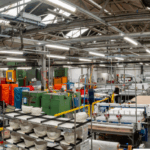England’s water supply could face far greater pressure than current forecasts suggest, as the Environment Agency (EA) admits it lacks reliable data on the rapidly growing water consumption of artificial intelligence (AI) data centres.
According to the EA, the country is already on track for a daily water shortfall of five billion litres by 2055, with an additional billion litres projected to be needed for industrial use, agriculture, and emerging technologies. However, that estimate excludes the usage of AI data centres—facilities that are expanding rapidly and drawing large volumes of water from public supplies for server cooling systems.
Officials within the EA told The Guardian that the omission leaves regulators unable to fully assess England’s future water needs. This year’s modelling was particularly challenging, they said, due to the explosive growth of AI infrastructure and a lack of mandatory reporting requirements on how much water data centres use.
AI data centres rely heavily on water-intensive cooling systems, such as evaporative and cooling tower setups, to prevent servers from overheating. Industry estimates suggest they consume between 1.8 and 12 litres of water per kilowatt-hour of electricity used. Globally, AI operations could require up to 6.6 billion cubic metres of water annually by 2027—about two-thirds of England’s total annual consumption.
Environment Agency Chair Alan Lovell said the looming deficit threatens not just household water supplies, but economic growth and food production. “Taking water unsustainably from the environment will have a disastrous impact on our rivers and wildlife,” he warned.
The pressure is mounting as the UK pushes ahead with plans to become a global leader in AI. Prime Minister Keir Starmer has pledged to cut red tape to fast-track data centre development in new “growth zones”, raising concerns about environmental oversight. Many of these centres continue to rely on public water systems rather than private or recycled sources, further stressing supply.
Water companies have proposed long-term infrastructure solutions—including new reservoirs, desalination plants, and recycling projects—but these initiatives are costly, time-intensive, and unlikely to be completed before demand surges.
Thames Water, currently leaking 570 million litres of water a day, has proposed a controversial £300 million drought resilience plan to pump treated sewage into the River Thames during dry periods. Critics, including MP Munira Wilson, have raised concerns about water quality and environmental risks. The EA has also warned that Thames Water has not yet demonstrated the feasibility of the scheme.
As households face rising water bills to help fund infrastructure upgrades and the government prepares to roll out nationwide smart meters, experts are calling for urgent reforms. Mandatory reporting of data centre water use, they argue, is essential to produce accurate projections and safeguard the country’s water future.








